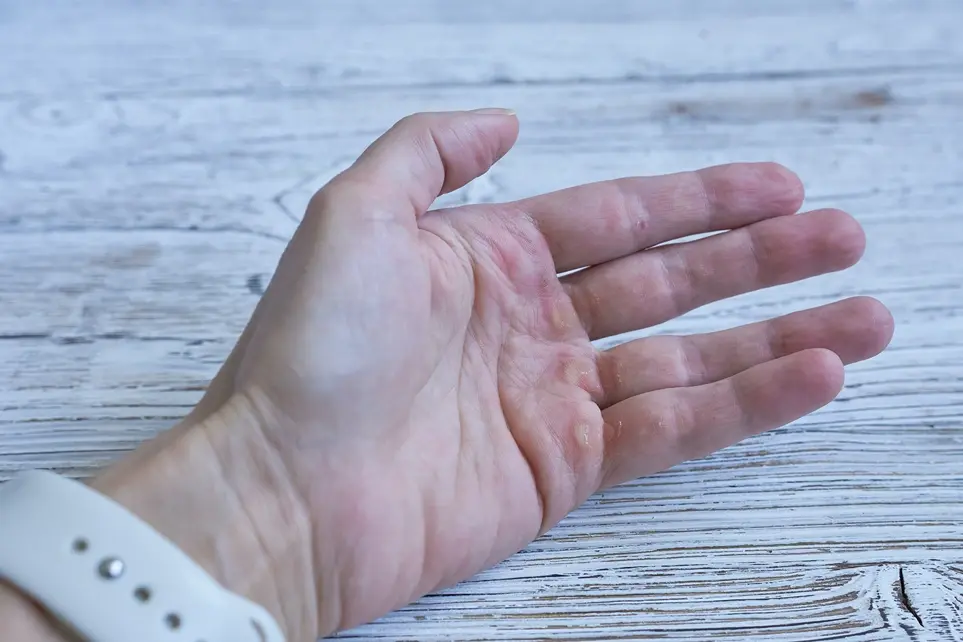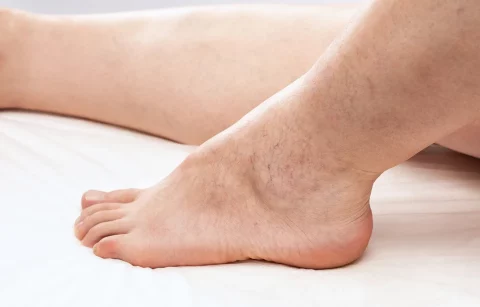Causes, Symptoms, and Minimally Invasive Treatments for Spider Veins on the Wrist

Spider veins on the wrist are small, tangled blood vessels that appear under the skin. They may cause mild swelling, discomfort, or distress over their appearance, so check with a vein specialist for treatment options.
Spider veins are a common venous disorder that can occur nearly anywhere on the body, including the wrists. While typically harmless, these small tangled blood vessels can cause discomfort or distress over their unsightly appearance.
If you have noticed spider veins developing on your wrists, you’re not alone. Read on to learn what causes them, how to find relief through minimally invasive treatments, and tips to prevent them from worsening.
Living with unwanted veins is a thing of the past, when you can simply schedule a free consultation with Vein Center Doctor and find your ideal solution today.
What Are Spider Veins?
Spider veins, also called telangiectasias, are tiny superficial blood vessels that appear just under the surface of the skin. They get their name from their spider-web-like shape.
While similar to varicose veins, spider veins are smaller, closer to the surface, and not usually associated with the pooling of blood or underlying venous insufficiency. Varicose veins are larger, deeper veins that sometimes protrude from the skin.
On the wrists, spider veins look like fine, red, blue or purple threadlike lines radiating outward. They are often harmless but can cause mild symptoms.
Learn more about the differences between spider veins and varicose veins and their mild symptoms by contacting our vein care experts today.
Recognizing the Symptoms of Wrist Spider Veins
Beyond the visibility of spider veins, some symptoms pointing to their development on the wrists include:
- Mild swelling around the veins
- Slight throbbing, burning or itching sensation
- Aching or heaviness in the wrists and hands
- Skin redness, irritation or discoloration around veins
- Hand cramps or fatigue with activity
The symptoms are typically subtle and pose little medical risk. But for some, the appearance of spider veins can be upsetting or limit wrist mobility due to discomfort. Catching them early provides more options for effective removal.
Why Do Spider Veins Develop on the Wrists?

There are several contributing factors that cause spider veins to emerge on the wrists and hands:
Hormonal Changes
Fluctuating estrogen levels in women during puberty, pregnancy, childbirth, and menopause can all trigger spider veins. The hormones relax the walls of blood vessels, allowing them to dilate and swell.
Genetics
Research shows there’s a hereditary predisposition for weakening blood vessel valves which leads to pooling. If spider veins run in your family, you are at an increased risk.
Prolonged Pressure
Habitual pressure on the wrists over time can compromise healthy circulation and blood flow. Wrist strain from repetitive work, playing sports, or typing exacerbates spider veins.
Sun Exposure
Ultraviolet radiation damages blood vessels over time, causing them to enlarge. Unprotected sun exposure on the hands is a contributing factor.
Medical Conditions
Certain underlying chronic medical conditions like blood clotting disorders, congestive heart disease, obesity, thyroid disorder and others can trigger spider veins.
Age
As we get older, our vein valves and vessel walls naturally weaken and are more susceptible to developing spider veins. They are most common after age 30.
Lifestyle
Lack of movement, smoking cigarettes, and being overweight all increase circulatory issues and irritation of blood vessels.
Find out if you may be genetically predisposed or have risk factors leading to spider veins on your wrists by scheduling a venous consultation.
Seeking Treatment for Spider Veins on the Wrists

While small spider veins on the wrists often don’t require medical treatment, it is smart to have them evaluated by your doctor. Some treatment options your physician may suggest include:
Lifestyle Changes
Limiting repetitive wrist motions, wearing compression sleeves, keeping arms elevated, exercise, weight control, and quitting smoking can help slow the progression of spider veins if caught early.
Home Remedies
Applying cool compresses, aloe vera, apple cider vinegar, witch hazel or horse chestnut extract topically may provide symptomatic relief and reduce inflammation. But evidence is limited on their ability to remove spider veins.
At Vein Center Doctor, our expert vein specialists offer the latest minimally invasive techniques to effectively treat wrist spider veins right in our office. We provide a customized treatment plan based on your specific veins and medical history.
Some of the advanced options we offer include:
Sclerotherapy
Our skilled specialists use ultra-fine needles to inject a specially formulated saline solution directly into the affected veins. This solution irritates the vein walls, causing them to collapse and seal shut. Over the next 4-6 weeks, the spider veins will fade away. Though multiple sessions may be required for complete removal, the procedure is virtually painless and requires no downtime.
VenaSeal
This cutting-edge procedure utilizes a medical-grade adhesive to permanently seal off and close wrist spider veins. Using ultrasound guidance, our specialist inserts a tiny catheter into the target vein and dispenses the adhesive. As it hardens, the vein collapses and closes. VenaSeal often achieves better results compared to sclerotherapy alone for permanent elimination of spider veins.
Compression Therapy
We may recommend prescription-strength compression stockings, wraps or pumps to gently improve blood flow and vein valve function in early stages. The external pressure helps blood circulate and discourages pooling in spider veins. This can stabilize veins and prevent new spider veins from emerging.
6 Ways to Help Prevent Wrist Spider Veins
While you can’t always prevent new spider veins from emerging, you can minimize risk factors to stop them from worsening with these tips:
- Wear Sunscreen: Protect your hands and wrists with an SPF 30+ broad spectrum sunscreen whenever outdoors to shield from UV damage. Reapply every 2 hours.
- Exercise Regularly: Get moving to improve overall vascular strength and blood flow. Activities like walking, swimming and strength training boost circulation.
- Maintain a Healthy Weight: Extra weight puts unnecessary pressure on blood vessels. Shedding excess pounds helps take the strain off.
- Elevate Your Hands: Lifting your arms and hands above heart level periodically reduces swelling and pooling of blood in the veins.
- Avoid Constraining Clothing: Wrist watches, tight sleeves or jewelry can constrict circulation. Opt for looser fitting clothing that doesn’t compress wrists.
- Stop Smoking: Chemicals in cigarettes and tobacco smoke harm blood vessels. Quitting improves vascular health and lowers future spider vein risk.
Consult our Vein Experts for Individualized Care

If you are bothered by the appearance of spider veins on your wrists or have pain limiting activity, seek professional vascular care. The experts at Vein Center Doctor offer personalized treatment plans and advanced techniques to remove spider veins and improve comfort.
With a skilled team of vein specialists, Vein Center Doctor has the experience and technology to accurately diagnose your wrist veins and match you with the right solution.
Don’t wait – request an appointment online today so our vein care experts can perform an accurate diagnosis and match you with effective spider vein removal.
Dr. Sood at Vein Center Doctor is always happy to offer free consultations to anyone looking to understand their vein issues. Don’t spend another day wondering how to make those visible veins go away. Call us at 862-227-1143 today!







